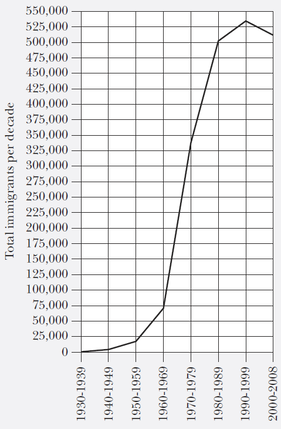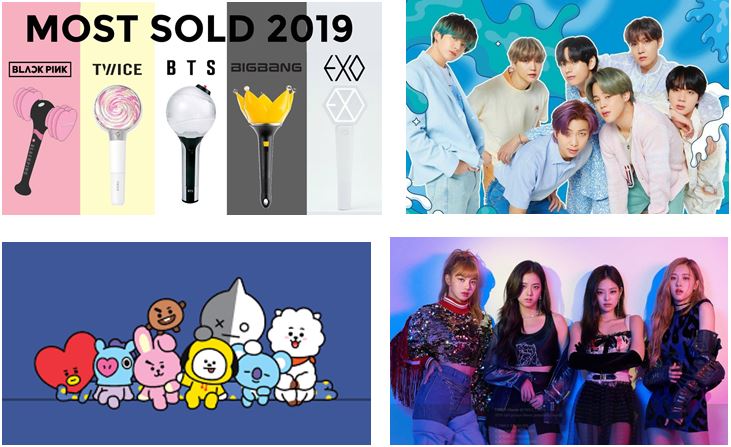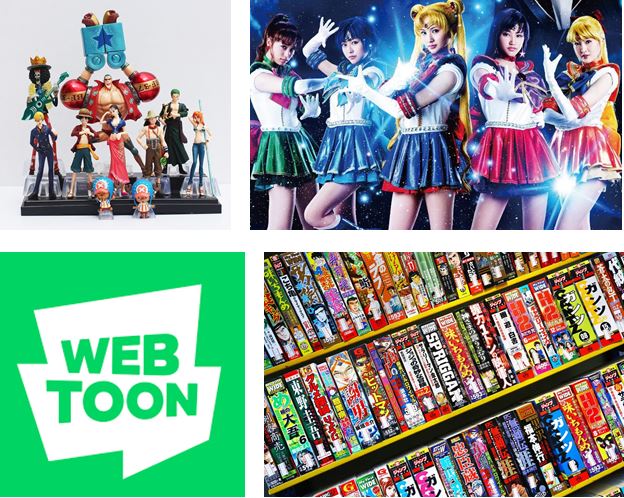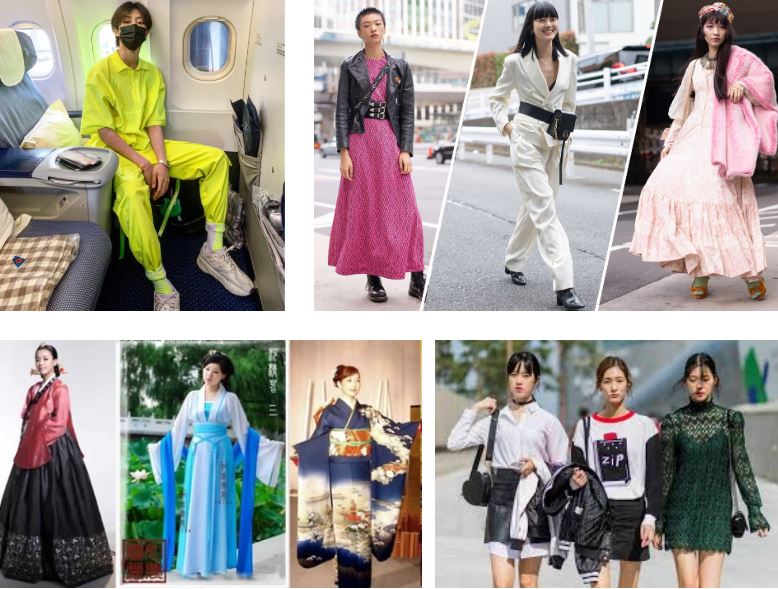|
Written by Thomas Le The diversity in America is one of its defining features. The country has earned its reputation as one of the most ethnically diverse nations in the world. Asians are no exception, however, one underrepresented group when addressing the topic of Asian immigration to the United States are the Filipinos. Acquired as a territory from Spain by the United States in 1989 after the latter’s victory in the Spanish-American War with the signing of the Treaty of Paris, the Philippines is home to around 106.7 citizens, all spread out on its 1,700 islands. Being a U.S. territory, newly gained citizenship allowed for several huge waves of immigrants to find new life in the states. This first and most wave was immediately after the annexation of the Philippines by the United States. The immigrants, usually settling in states on the west coast such as California, were very limited in their numbers, with only around a few hundred settling in the 1930’s. This was mainly due to the passing of the Tydings-McDuffie Act which restricted the number of Filipino immigrants 100 per year. Throughout WW2, where Filipino soldiers actively fought against Japanese expansion alongside the United States. In recognition of their valiant efforts, the United States passed both the Filipino Naturalization Bill and the War Brides Act which gave any man and his who served in the military their wife the opportunity to become U.S. citizens. The bill warranted more than also allowed for any Filipinos currently living in the U.S. to also become citizens. By the years following the end of war, the Philippines had gained its independence with the Treaty of Manila in 1946 and up onto the 1960’s, as many as 65,000 veterans and their wives immigrated to the United States. People other than veterans also came to the U.S. as in 1948, the U.S. Congress passed the Education Exchange Act, which enabled foreign nurses to spend two years in the United States for study and professional experience, and joined the other legislations that promoted the immigration of a new category of Filipinos who would join the growing Filipino American population. Immediately after the second wave, the third most notable wave of immigration hit in 1965 when President Lyndon B. Johnson passed the Immigration and Nationality Act, which ended national quotas, and provided an unlimited number of visas for family reunification. Numbers skyrocketed as by the end of the 20th century, the amount of immigrants had shot up from 75,000 in 1961 to 550,000 in 2000, and ever since then, the population has been steadily growing. Now, with over 4 million members living all over the United States, the Filipino community continues to spread its influence of culture with figures such as Bruno Mars becoming one of the most popular artists of the 21st century to Ben Cayetano who served as the fifth governor of the United States. Sources
0 Comments
Written by Steven Le Many famous rappers and pop culture icons can always be seen sporting their most eloquent, decadent pieces of jewelry. From the likes of Snoop Dogg and Travis Scott to Jeff Goldblum, you can see grills, rings, watches, the works, all studded in gold and diamonds; and the man icing out these icons is none other than Vietnamese-born Johnny Dang, the King of Bling.
Johnny Dang, born Thanh Dang, was born in the Đắk Lắk Province of Vietnam towards the end of the Vietnam War. He lived without electricity or clean water in his village. It was in 1996 when Dang would make his move to Houston, Texas, and begin his work in jewelry repair at a local flea market. Dang only had $500 to live off of for six months when he first came to the United States. In an interview with VICE, he said that he initially didn’t get a job for jewelry repair in the flea market, as the manager said he had no experience. So, Dang rented the space right above him as direct competition. Dang didn’t build his brand with rappers on purpose, but by chance. The catalyst to Dang’s future success was when he met Houston-based rapper Paul Wall. The rapper was most impressed with Dang’s grills, and the pair went into business in 2002. With Wall’s help, Dang’s popularity skyrocketed, especially after helping to pioneer the trend of diamond grills. Paul Wall was an instrumental part of Dang’s success, helping him communicate with more and more artists to build his brand. Now, Johnny Dang himself is a pop culture icon. He’s had cameos in music videos and songs from Migos, Nelly, Trippie Redd, DaBaby, and Beyonce just to name a few. It was Dang’s work ethic and skill that brought him to this level of popularity. “I feel very blessed, you know, and cool. So you know I’ve been working so hard to build my name strong enough, like a brand name”. Johnny Dang represents in the media what many Asian individuals live for: the American Dream. Dang says that it’s a dream come true that he, a little Asian boy from Vietnam, can be where he is now. He proudly represents and establishes an Asian presence in pop culture. Even now, he is humble and hard-working, constantly wanting to improve himself and his brand. It was his determination and work ethic that brought him from his 450 square foot repair store to his solid brand name that many in the rap community are loyal to. From poverty to the King of Bling, Johnny Dang is the symbol of the Asian-American dream. By Alex Tao and Jocelyn Lam “F— you Asians,” “Go back to whatever f—— Asian country you’re from”, said a San Francisco Tech CEO to Jordan Chan’s family while they were celebrating a birthday on the Fourth of July this year. The family, very shaken from the ordeal, noted that although they had faced racism in the past, this particular incident was on another scale. The last 6 months have shaken America to its core, unearthing much deep-seeded racism against minority groups with Asian Americans becoming one of the largest targets for hate. Back in March, when the coronavirus was becoming widespread throughout America, the Asian Pacific Policy and Planning Council launched a hate crime reporting website in California for victims of race-based violence and verbal harassment. Of the 832 self-reported incidents of hate crimes and discrimination, the website marked 81 reports of physical assault and 64 potential violations of civil rights in California. These reports, along with media coverage of unprovoked racist tirades and even the burning of an 80-year-old woman in New York, paint a scary picture of the danger that confronts millions of Asian Americans today.
From being spat on, told to “go back to your country”, to being sprayed with water, many Asian Americans have come forward in recent times with stories of their racist and xenophobic experiences. Data collected on these incidents show that there is a strong correlation between the increase in hate crimes with public statements given by government officials such as President Trump, with many of the assailants in the attacks parroting Mr. Trump’s “China Virus” term. The racist rhetoric coming from the highest office in the land has created a dangerous environment for Asian Americans. In particular, the wellbeing of elderly Asian Americans has come under significant risk, as many of them do not speak English, which is a restriction when it comes to reporting racist incidents. It must also be noted that the number of cases reported and videos that the media have displayed only begin to scratch the surface of the violence and discrimination perpetrated against minorities since many of the incidents often go unreported. As COVID-19 spread worldwide, and different countries began taking preventative measures to stop the spread, the head of America’s government only stood back and watched. In multiple interviews and public announcements, Trump continues to refer to the coronavirus with different names, all shining a dark shadow on the Asian community. The use of terms such as “kung flu” and “Chinese virus” perpetuates the idea that all Asians caused and currently have the virus. Trump’s use of these terms fuels the rising hate crimes against Asians, and his team only stands by with weak defense against it. While this is not a new topic to the community, it’s an important one to be addressed, as the normalization of racism towards Asians worsens each day. This is present in the everyday microaggressions Asian Americans face, such as assumptions of intelligence due to race, questions such as “where are you really from?”, which takes on the idea that all Asian Americans are foreign-born, and treating the Asian community as second class citizens, ones who don’t belong or hold value compared to Caucasians. On top of this, popular companies will push the idea of casual racism in their products, taking traditional prints and symbols into an “exotic selling point.” Stores such as Urban Outfitters, Shein, and ASOS, have taken traditional prints from Asian culture and used them in their clothing lines. An example used over the decades is the Chinese qipao, popularized in the 1920s for Chinese women in Shanghai. However, the traditional prints and cut of the dress have been taken and cut short, now seen as a little mini dress with an “oriental” print. It demeans the value and culture behind Asian symbols and only continues to grow as more people and companies keep getting with casual racism. This is a worldwide issue that needs to be handled, especially in America. If the U.S. stays on this path to ignore the pandemic and put millions of lives in danger, the hate and racism against Asians will only suffer, as our lives and culture will be put on the line, stripped away without a fight. As Asian Americans, we must remember to take pride in our culture and speak out when we see it being encroached on. To concerned readers with elderly relatives that speak English as a second language, it may be wise to sit them down and discuss courses of action to take if ever faced with a confrontational situation. We must be vigilant in the face of this era and not allow xenophobia to control our lives. Sources: https://sanfrancisco.cbslocal.com/2020/07/07/racist-comments-asian-family-viral-video-san-francisco-tech-ceo-michael-lofthouse/ https://sanfrancisco.cbslocal.com/2020/07/05/800-hate-crimes-against-asians-in-california-reported-in-past-3-months/ https://www.hrw.org/news/2020/05/12/covid-19-fueling-anti-asian-racism-and-xenophobia-worldwide# https://www.adl.org/blog/reports-of-anti-asian-assaults-harassment-and-hate-crimes-rise-as-coronavirus-spreads https://www.sun-sentinel.com/opinion/commentary/fl-op-com-lantigua-asian-americans-coronavirus-hate-attacks-20200407-rk7nak2jlbautmnzfd2c2uvbnq-story.html“Get this corona virus chink away from me” https://sph.umn.edu/site/docs/hewg/microaggressions.pdf Written by Jiya Sishodia, Edison Cheung, & Yvonne Tsao n both Asia and America, there’s a significant rise in many similar trends. These trends range from music to food to makeup, but the most prominent of these rising trends are the rise in the popularity of Kpop, Anime, and Asian fashion. Kpop: Kpop is a phenomenon that has taken over the world in the past couple of years. It is commonly interpreted as “Korean-pop” but in fact, has many different sounds and genres within it. Some of the most well-known idol groups include Blackpink, BTS, Twice, Red Velvet, GOT7, and EXO. Events like KCON, an annual convention dedicated to the genre of music have seen huge success in the U.S. Without further ado, let us talk about the growing popularity of Kpop. Blackpink: Blackpink is a 4 member group that has taken not only Asia but the western population by storm. With their official debut in 2016 under YG (one of Korea’s top 3 entertainment companies) they quickly gained popularity. Their hit lead single "DDU-DU DDU-DU” broke international barriers, garnering over 1 billion views on Youtube, currently making it the 3rd most viewed Kpop song ever! The group has won over 40 awards including the Golden Disc award and Seoul Music Award. Their comebacks constantly rank on top 100 billboard charts and even performed at Coachella 2019. Their most recent single “How You Like That” released on June 26 reached 86 million views within 24 hours on Youtube, making it the world record. The 4 girls have truly gained the attention of many, even becoming global ambassadors for brands like Chanel, Bvlgari, and Saint Laurent. BTS: BTS, the biggest Korean boy group on the planet right now. They debuted in 2013 under a small company, Big Hit Entertainment, with their lead single “No More Dream”. The 7 member group gradually increased in popularity until in 2015, they really started to get noticed in the western world as well with their release of the albums “The Most Beautiful Moment in Life Pt. 1 and Pt. 2”. 2015 also marked the year BT21 was created, a brand collaboration between BTS and Line Friends. Currently, they already have over 200 awards, were nominated for the 2020 Grammy Awards, and have performed at the BBMAs. The group has been featured in ads for Hyundai, Samsung, and more. Their most recent studio album “Map of The Soul: 7” sold over 4 million copies in less than 9 days, breaking the world record in South Korea for the fastest-selling album. Overall the 7 member group has made a global impact and is continuing to grow their fanbase. Fandom Culture: Kpop fans as a community have many different ways of sharing their love for the culture together. Idol groups will often create fandom names to address their fans and supporters with appreciation and affection such as how kpop group “Monsta X” fans are called Monbebes, (meaning “My baby” in French). Kpop fans also purchase albums and other merchandise from their favorite groups, which include photobooks, photocards, stickers, posters and more. People within the fandoms can trade these photo cards and stickers with others within the community to collect cards of members they want. Lightsticks are another well-known part of Kpop culture, which are hand-held lights specific to each group with unique designs that set them apart from each other. These lightsticks are designed to be used at concerts and events for fans to show support for their favorite groups. Anime: Anime (short for animated Japanese comics/cartoons) has been around for decades, but has become extremely popular within the last 10 years. Fans vary from every age group, gender, and race. These comics/cartoons come in countless genres, such as romance, comedy, mystery, horror, action, and adventure. Due to the growth of international popularity, anime is often subtitled or dubbed in different languages from all around the world. Many anime movies become so popular that they are released in western theaters as well. Some of the most popular anime are “One Piece”, “Avatar the Last Airbender”, “Naruto”, “Pokémon” , and “Dragonball Z”. Manga: Most anime are based off of manga, which are Japanese comics or graphic novels. Manga is created by writers and artists from Japanese studios such as Kyoto animation, Toei animation, Bones, and Madhouse. Manga is sold in Japanese bookstores, and is often translated into other languages such as English for international fans. Many fans read webtoons, which is manga that are posted online so viewers can read them virtually. Fandom Culture: Fans of Japanese cartoons or comics are often called “Otakus”. These fans often come together at multiple anime conventions around the world. Many fans participate in “cosplay” which is when a fan dresses up as an anime character. Fans also buy countless merchandise such as posters, clothes, and figurines of their favorite anime. Fashion: Asia is well-known for the unique and beautiful traditional clothing from each country, influencing many designs around the world. One style in particular that has grown internationally famous-- especially among younger generations-- is Asian streetwear. Asian streetwear differs by country, but often contains fancy traditional clothing or of expensive designer brands. Often worn by models, celebrities, and online influencers, it has become a globally popular topic in social media, such as “TikTok” and “Instagram”. Different Streetwear Styles: Although traditional clothing is commonly worn daily across Asia, many countries have their own unique streetwear styles. In Japan, Lolita styles-- goth, punk, or sweet Lolita styles stemming from the 80s victorian style clothing and fashion-- and Harajuku style-- mixed style of sweet/gothic Lolita, cosplay, cutesy fairy kei, punk rock, and traditional Japanese clothes used to defy the strict societal rules and standards in Japan-- are commonly worn. However in Korea, athleisure, professional style (such as pant suits and blazers), simplistic/monotone style, and oversized clothing is commonly worn. Whereas in China, commonly worn styles include sheer clothing, bright/neon clothing (which usually includes bold accessories), and juxtaposing (contrasting, such as black and white) clothing. Many of these listed styles and more are trending in western countries such as the U.S, while fans and western celebrities attempt to recreate outfits/styles or while many western designs are influenced by Asian fashion. (all photos taken from Google)
|
Description
For the 2020-21 season, REACH will be releasing a new blog post written by our officers during the first and third Wednesdays of each month about different aspects of Asian culture, such as pop culture, conflicts faced, representation in media, history, celebration and holidays, and stereotypes. We hope you enjoy reading them! Archives
March 2021
Categories |





 RSS Feed
RSS Feed
